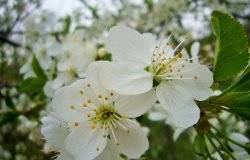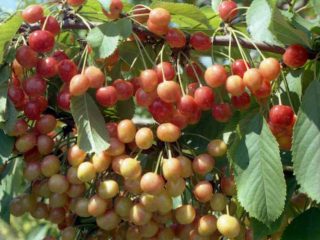Content
Cherry Donetsk coal is one of the most favorite varieties among gardeners. Unpretentiousness in care, high yield and excellent taste of the fruit are the reasons for its high popularity.
History of selection
The Ugolek cherry variety was bred in 1956 in the Donetsk region at the Artemovsk Experimental Nursery Station at the Institute of Horticulture of the Ukrainian Academy of Agrarian Sciences. The author is an outstanding breeder, Honored Agronomist of Ukraine - Liliya Ivanovna Taranenko. It arose as a result of crossing the varieties Valery Chkalov and Drogana yellow. Introduced into the State Register of Breeding Achievements since 1995.
A photo of the Ugolek cherry can be seen below.
Description of culture
The cherry tree is medium-sized, with a spherical crown of medium density, reaching 3.5 m in size. The leaves are oval, with serrated serrations along the edge. The fruits are dark burgundy, round, slightly flattened, dense in consistency, sweet. The stalk is of medium length and thickness, and comes off dry even in unripe berries. The bone is well separated from the pulp. The root system is horizontal, skeletal roots are formed during the first year. The description of the Ugolek cherry variety determines its most important characteristics:
- Early fruiting - bears fruit in the 4th-5th year.
- Self-sterile - requires replanting 1-2 trees for pollination.
- Growing season – mid-late variety.
Cherry Ugolek grows well in the temperate climates of Southern, Western and Eastern Europe. In Russia, it is successfully cultivated in the North Caucasus, Crimea, and Krasnodar Territory. It is possible to plant the plant in the Central Black Earth region of Russia, but without hope for high yields.
Characteristics
At the beginning of its life, the tree grows quickly, and by 4-5 years it has completely formed a crown. The foliage sparsely covers the branches, which promotes air circulation and high-quality pollination.
Drought resistance, winter hardiness
Frost resistance is above average. Cherries cannot tolerate frosts below -250C – either freezes severely or dies before the fruiting period. May not bear fruit due to freezing of the buds. Tolerates drought well.
Pollination, flowering period and ripening time
High productivity of Ugolek cherries is achieved only as a result of cross-pollination. Blooms during the period when the average daily temperature does not fall below +100C. In the southern regions - in early April, in the northeast - in early May. The flowering period lasts from 15 to 25 days depending on weather conditions. Pollinator for cherry Ugolek is a variety that blooms at the same time as it. The varieties Donchanka, Yaroslavna, Valery Chkalov, Aelita, Drogana yellow, Valeria, Annushka, Donetskaya krasavitsa are suitable for this purpose. Donetsk coal ripens by the end of June - mid-July.
Productivity, fruiting
Full fruiting begins 5-7 years after planting. From an adult 10-year-old tree you can collect up to 100 kg of berries. The quality of the crop is affected by the weather during flowering.In damp and cool spring, the activity of pollinating insects decreases, and in the heat, the reproductive properties of pollen deteriorate.
Resistance to diseases and pests
As a result of breeding work, the Ugolek variety demonstrates immunity to diseases, in particular coccomycosis. Resistant to pest attack, but preventive and protective measures must be taken.
Advantages and disadvantages
Reviews of Ugolek cherries from gardeners are always friendly and cover the positive and negative characteristics of the variety. The advantages include:
- Compact crown dimensions.
- Easy care.
- Resistance to frost and drought.
- Excellent taste characteristics
- High yield
- Versatility - good for canning, making juices, compotes, fruit wines.
The description of the Donetsk Ugolek cherry reveals the following negative aspects:
- Cracking of berries in conditions of high humidity during fruiting.
- The need to control the growth of the crown, cut out shoots growing upward.
Conclusion
Cherry Donetsk Ugolek lives up to 100 years, but the most productive years are 15-25 years. Planting is done in early spring or mid-autumn. Select 1-year-old seedlings with 3-4 branches of the taproot. It grows well and bears fruit on loamy and sandy loamy soddy-podzolic soils with a pH of 6.5-7.Young plants need to be watered abundantly (1-2 buckets of water 2 times a week and during drought 3 times a week).












